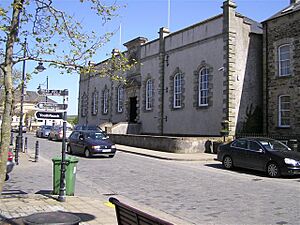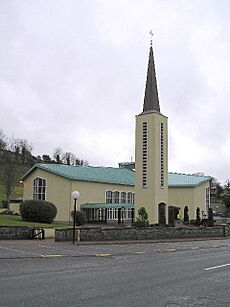Lifford facts for kids
Quick facts for kids
Lifford
Leifear
|
|
|---|---|
|
Town
|
|

The Three coins sculpture, Lifford
|
|
| Country | Ireland |
| Province | Ulster |
| County | County Donegal |
| Barony | Raphoe North |
| Dáil constituency | Donegal |
| Elevation | 6 m (20 ft) |
| Population
(2022)
|
|
| • Total | 1,613 |
| Time zone | UTC±0 (WET) |
| • Summer (DST) | UTC+1 (IST) |
| Eircode routing key |
F93
|
| Telephone area code | +353(0)74 |
| Irish Grid Reference | H330984 |
Lifford (called Leifear in Irish) is a town in County Donegal, Ireland. It is the main administrative centre for the county. You might sometimes hear people mistakenly think Letterkenny holds this role, but Lifford is the official county town.
Lifford is located in the Finn Valley area of East Donegal. Here, the River Finn and the River Mourne meet to form the River Foyle. Another river, the Burn Dale, also flows into the River Foyle just outside Lifford.
Contents
History of Lifford
The town of Lifford grew around a castle built in the 1500s. This castle was built by Manghus Ó Domhnaill, who was the ruler of Tír Chonaill (which is mostly modern-day County Donegal).
Lifford later became a British Army military town. This meant soldiers were stationed there. It remained a military town until most of Ireland became independent in December 1922, forming the Irish Free State.
Lifford is located across the River Foyle from Strabane, a town in Northern Ireland. The two towns are connected by Lifford Bridge.
Building Lifford Castle
Manus O'Donnell started building Lifford Castle in 1527. He finished the main parts of the castle by the end of that summer. This was impressive because he was at war with the O’Neill family from Tír Eoghain at the time.
In 1543, the castle was given to Cahir O'Gallagher to guard for the O’Donnell family. However, Cahir decided to keep it for himself and removed people loyal to the O’Donnells. In 1544, Calvagh O'Donnell went to the English Lord Justice for help. He returned with English soldiers and special equipment to take the castle back from the O’Gallaghers.
During the attack, the O’Gallaghers refused to surrender. Sadly, one of the O'Gallaghers, Cahir, was killed. The castle was then given back to O’Donnell. Lifford Castle is no longer standing today.
Battles and Rebellions
A battle known as the Battle of Lifford took place here in 1600 during a conflict called Tyrone's Rebellion.
After O'Doherty's Rebellion ended in 1608, some captured rebels were brought to Lifford. They were put on trial and then executed. One well-known rebel who was executed here was Phelim Reagh MacDavitt.
In 2008, Lifford received national recognition in the Tidy Towns Awards. It was named the best new town to enter the competition in its category.
People in Lifford
Lifford had a population of 1,613 people according to the 2022 census. This was a small decrease from the 2016 census. In 2016, there were 794 males and 832 females living in the town.
Lifford is part of the Clonleigh Civil Parish. This larger area has a population of 3,547 people. For voting purposes, the parish is divided into two areas: Clonleigh North and Clonleigh South.
Education in Lifford
Lifford has several primary schools, also known as "National" schools. For secondary school, students usually travel to nearby towns like Raphoe, Stranorlar, or even Strabane in Northern Ireland.
Here are the primary schools in Lifford:
- St. Patrick's (Murlog National School): In 2020/21, it had 179 pupils (96 boys and 83 girls).
- Scoil Mhuire gan Smal (Lifford National School): In 2020/21, it had 107 pupils (57 boys and 50 girls).
- Scoil Cholmcille Naofa (Ballylast National School): In 2020/21, it had 36 pupils (18 boys and 18 girls).
- Scoil Bhrighde (Boyagh National School): This school closed permanently in March 2018.
- Scoil Cholmcille (Cloughfin National School): In 2020/21, it had 32 pupils (12 boys and 20 girls).
Some other primary schools in the area, like Blackrock National School and Ballindrait National School, have closed over time. There were also fee-paying schools, The Prior Endowed School and The Hansard Grammar School, which are now closed.
Historical Buildings and Places of Interest
Lifford Courthouse
Lifford Courthouse is now a restaurant and a heritage centre. It is located near the County House, which is the main office for Donegal County Council. The courthouse was built in 1746. Today, the museum inside shows documents and items related to the O'Donnell clan. You can also see some of the original prison cells from when it was a courthouse.
Lifford Gaol
Lifford Gaol was once the main prison for all of County Donegal. It was located in the town centre but was taken down in 1907.
Cavanacor House
Cavanacor House is just outside Lifford. It was once the home of the great-great-great-grandmother of James Knox Polk, who became the 11th President of the United States of America. She was born here in 1634. King James II also had dinner at Cavanacor House in 1689 when he was on his way to the Siege of Derry.
Prior Endowed School
This school was built in 1880 for local Protestant children. It was funded by money left by Miss Eleanor Prior. The Prior School closed in 1972 and joined with another school to form The Royal & Prior Comprehensive School in Raphoe. The building was later used by the Irish Defence Forces as a military barracks, but this barracks also closed in 2009.
St. Lugadius's Church

St. Lugadius's Church, also called Clonleigh Parish Church, was built in 1621. Sir Richard Hansard, who owned land in Lifford, wanted a church built there. Inside the church, there is a monument to Sir Richard and his wife. In the churchyard, George Gardiner is buried. He won a Victoria Cross (a very brave award) during the Crimean War in 1855.
St. Patrick's Church
St. Patrick's Church, often called Murlog Chapel by local people, is a Catholic church. The first church on this site was built in the 1700s. The current church was built in 1963. An old stone tower from the original church, built around 1820, was saved and still stands next to the new church.
Lifford Community Hospital
This hospital was once the main hospital for all of County Donegal. It is located by the River Foyle. The hospital first opened at this location in 1773. Today, the hospital cares for people who need long or short-term stays. It also offers services like Physiotherapy and chiropody for people in the East Donegal area.
Hansard's Grammar School
Sir Richard Hansard's will in 1619 also helped set up a private school in Lifford. This school, Hansard's Grammar School, aimed to teach classical subjects. Children from Clonleigh parish were supposed to get free education there. The school started in 1697 but faced problems over time. It eventually closed.
Getting Around Lifford
Road Travel
Lifford is known as the "Gateway to Donegal." This is because it's often the first town you reach in County Donegal when traveling from Dublin. Drivers cross Lifford Bridge to enter the town. Two main national roads, the N15 (going towards Sligo) and the N14 (going towards Letterkenny), help people travel to different parts of the county. There is also a route to Derry City.
Lifford has several daily bus services run by Bus Éireann. These buses go to Dublin Airport and Dublin City Centre. You can also get buses to Letterkenny and Ballybofey, where you can connect to other services, including trains to Sligo. Lifford is also close to Strabane Bus Depot in Northern Ireland, where Ulsterbus operates services to places like Derry, Belfast, and Omagh.
Air Travel
City of Derry Airport is the closest airport to Lifford, about 20 miles away.
Train Travel
Lifford Halt railway station opened in 1909 but closed in 1960. Lifford used to be a stop on a narrow gauge railway line that went from Strabane to Letterkenny.
Today, the nearest train station is Waterside Station in Derry. This station is run by Northern Ireland Railways and has trains that go to Coleraine and then on to Belfast.
Sports in Lifford
Lifford is home to several sports clubs:
- Naomh Pádraig GAA Club: This Gaelic Athletic Association (GAA) club was founded in 1953 as Lifford GAA Club. They play Gaelic football in the Donegal Football League Division 5. Their home games are played at Páirc MacDairmada (McDermott Park).
- Lifford Celtic Football Club: This football club plays in Division Two of the Donegal Junior Football League. They play their home games at Greenbrae Park in Lifford.
- Deele Harps Football Club: This club was founded in 1980 and also plays in Division Two of the Donegal Junior Football League. They have a new football ground in Ballindrait, just outside Lifford.
- Lifford Strabane Athletic Club: This club trains at its athletic track and grounds in the Roughan area.
- St. Patrick's (Clonleigh) Bowling Club: This club plays indoor bowls in the Donegal Indoor Bowling League Division Two.
Voluntary Organisations
Many voluntary groups help out in the Lifford area:
- Strabane/Lifford Rotary Club: This is a charitable group that is part of Rotary International. They work to help the community.
- Lifford Youthreach: This program is part of the Donegal Education and Training Board. It provides training and education for young people who have left school early. It helps them gain skills and qualifications.
- Lifford Scout Group: Also known as the 19th Donegal (Lifford) Scout Group, it was formed in 1985. Lifford Scouts are part of Scouting Ireland.
- Lifford/Clonleigh Mens Shed: This is a voluntary group where local men can meet up. They can learn new skills like woodworking or gardening, or simply enjoy a cup of tea and chat with other men. You can find more information on their Facebook page: Mens Shed Lifford.
Famous People from Lifford
- Alexander Allison (1799–1862) – Born in Lifford, he later became the Mayor of Nashville, Tennessee, in the United States.
- Peter Benson (c.1570-1642) – An architect who helped build the Walls of Derry. He owned a lot of land in Lifford.
- Sharon Foley (b. 1972) – An athlete who holds the Senior Irish National Record for the Heptathlon (a seven-event competition).
- George Gardiner (1821–1891) – He won a Victoria Cross for his bravery during the Crimean War. He died in Lifford and is buried in Clonleigh Churchyard.
- Shay Given (b. 1976) – A famous football goalkeeper. He played for Ireland many times, holding the record for most appearances for a long time.
- Mickey Joe Harte (b. 1973) – A singer-songwriter who represented Ireland in the Eurovision Song Contest in 2003.
- Paddy Harte (1931–2018) – A former politician who served in the Irish Parliament and as a government minister.
- William Hilton (died 1651) – A Member of Parliament and a High Court judge.
- Senator Patrick McGowan (1926–1999) – A politician who was a member of the Irish Senate (Seanad Éireann) for many years.
- Alexander Montgomery (1720–1800) – A politician who represented Lifford in the Irish Parliament.
- Aodh Ruadh Ó Domhnaill (Red Hugh O'Donnell) (1572–1602) – A powerful leader and king of Tír Chonaill.
- George Otto Simms (1910–1991) – A historian and a leader in the Church of Ireland, serving as Archbishop of Armagh.
- Matthew Sweeney (1952–2018) – A poet who was born in Lifford.
Images for kids
See also
 In Spanish: Lifford para niños
In Spanish: Lifford para niños







